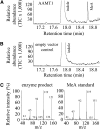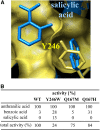Herbivore-induced SABATH methyltransferases of maize that methylate anthranilic acid using s-adenosyl-L-methionine
- PMID: 20519632
- PMCID: PMC2923889
- DOI: 10.1104/pp.110.158360
Herbivore-induced SABATH methyltransferases of maize that methylate anthranilic acid using s-adenosyl-L-methionine
Abstract
Volatile methyl esters are common constituents of plant volatiles with important functions in plant defense. To study the biosynthesis of these compounds, especially methyl anthranilate and methyl salicylate, we identified a group of methyltransferases that are members of the SABATH enzyme family in maize (Zea mays). In vitro biochemical characterization after bacterial expression revealed three S-adenosyl-L-methionine-dependent methyltransferases with high specificity for anthranilic acid as a substrate. Of these three proteins, Anthranilic Acid Methyltransferase1 (AAMT1) appears to be responsible for most of the S-adenosyl-L-methionine-dependent methyltransferase activity and methyl anthranilate formation observed in maize after herbivore damage. The enzymes may also be involved in the formation of low amounts of methyl salicylate, which are emitted from herbivore-damaged maize. Homology-based structural modeling combined with site-directed mutagenesis identified two amino acid residues, designated tyrosine-246 and glutamine-167 in AAMT1, which are responsible for the high specificity of AAMTs toward anthranilic acid. These residues are conserved in each of the three main clades of the SABATH family, indicating that the carboxyl methyltransferases are functionally separated by these clades. In maize, this gene family has diversified especially toward benzenoid carboxyl methyltransferases that accept anthranilic acid and benzoic acid.
Figures










Similar articles
-
Molecular basis of one-step methyl anthranilate biosynthesis in grapes, sweet orange, and maize.Plant J. 2024 Sep;119(5):2363-2374. doi: 10.1111/tpj.16922. Epub 2024 Jul 8. Plant J. 2024. PMID: 38976445
-
Anthranilate N-methyltransferase, a branch-point enzyme of acridone biosynthesis.Plant J. 2008 Feb;53(3):541-53. doi: 10.1111/j.1365-313X.2007.03360.x. Epub 2007 Nov 6. Plant J. 2008. PMID: 17988223
-
Molecular and biochemical characterization of the jasmonic acid methyltransferase gene from black cottonwood (Populus trichocarpa).Phytochemistry. 2013 Oct;94:74-81. doi: 10.1016/j.phytochem.2013.06.014. Epub 2013 Jul 9. Phytochemistry. 2013. PMID: 23849543
-
Floral benzenoid carboxyl methyltransferases: from in vitro to in planta function.Phytochemistry. 2005 Jun;66(11):1211-30. doi: 10.1016/j.phytochem.2005.03.031. Phytochemistry. 2005. PMID: 15946712 Free PMC article. Review.
-
[Analogs of S-Adenosyl-L-Methionine in Studies of Methyltransferases].Mol Biol (Mosk). 2022 Mar-Apr;56(2):296-319. doi: 10.31857/S0026898422020148. Mol Biol (Mosk). 2022. PMID: 35403621 Review. Russian.
Cited by
-
Genome-wide identification and expression pattern analysis of the SABATH gene family in Neolamarckia cadamba.For Res (Fayettev). 2023 May 29;3:13. doi: 10.48130/FR-2023-0013. eCollection 2023. For Res (Fayettev). 2023. PMID: 39526264 Free PMC article.
-
Trichomes and unique gene expression confer insect herbivory resistance in Vitis labrusca grapevines.BMC Plant Biol. 2024 Jun 27;24(1):609. doi: 10.1186/s12870-024-05260-9. BMC Plant Biol. 2024. PMID: 38926877 Free PMC article.
-
Early transcriptome analyses of Z-3-Hexenol-treated zea mays revealed distinct transcriptional networks and anti-herbivore defense potential of green leaf volatiles.PLoS One. 2013 Oct 14;8(10):e77465. doi: 10.1371/journal.pone.0077465. eCollection 2013. PLoS One. 2013. PMID: 24155960 Free PMC article.
-
Phenolic metabolism in the hornwort Anthoceros agrestis: 4-coumarate CoA ligase and 4-hydroxybenzoate CoA ligase.Plant Cell Rep. 2020 Sep;39(9):1129-1141. doi: 10.1007/s00299-020-02552-w. Epub 2020 May 13. Plant Cell Rep. 2020. PMID: 32405654 Free PMC article.
-
Microbial production of methyl anthranilate, a grape flavor compound.Proc Natl Acad Sci U S A. 2019 May 28;116(22):10749-10756. doi: 10.1073/pnas.1903875116. Epub 2019 May 13. Proc Natl Acad Sci U S A. 2019. PMID: 31085637 Free PMC article.
References
-
- Barkman TJ, Martins TR, Sutton E, Stout JT. (2007) Positive selection for single amino acid change promotes substrate discrimination of a plant volatile-producing enzyme. Mol Biol Evol 24: 1320–1329 - PubMed
-
- Cardoza YJ, Tumlinson JH. (2006) Compatible and incompatible Xanthomonas infections differentially affect herbivore-induced volatile emission by pepper plants. J Chem Ecol 32: 1755–1768 - PubMed
-
- Chen F, D'Auria JC, Tholl D, Ross JR, Gershenzon J, Noel JP, Pichersky E. (2003) An Arabidopsis thaliana gene for methylsalicylate biosynthesis, identified by a biochemical genomics approach, has a role in defense. Plant J 36: 577–588 - PubMed
-
- D'Alessandro M, Held M, Triponez Y, Turlings TCJ. (2006) The role of indole and other shikimic acid derived maize volatiles in the attraction of two parasitic wasps. J Chem Ecol 32: 2733–2748 - PubMed
-
- D'Auria JC, Chen F, Pichersky E. (2003) The SABATH family of MTS in Arabidopsis thaliana and other plant species. Romeo JT, , Integrative Phytochemistry: From Ethnobotany to Molecular Ecology. Recent Advances in Phytochemistry, Vol 37 Elsevier, Oxford, pp 253–283
Publication types
MeSH terms
Substances
Associated data
- Actions
- Actions
- Actions
- Actions
- Actions
LinkOut - more resources
Full Text Sources
Other Literature Sources
Molecular Biology Databases

